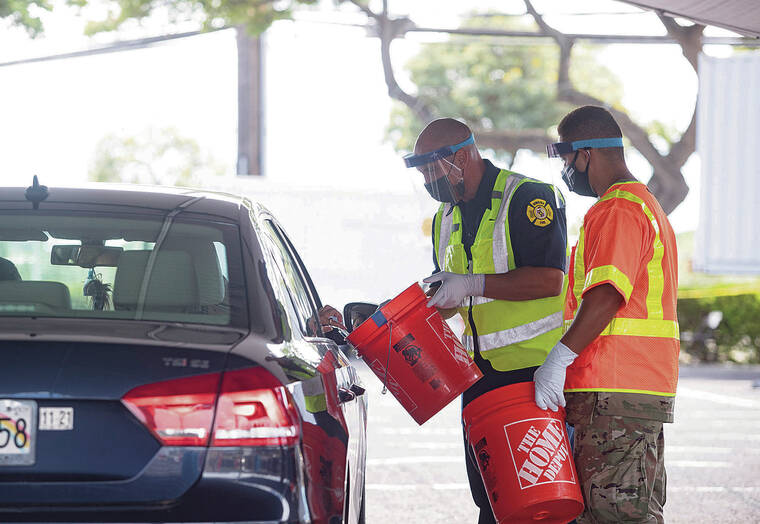COVID-19 delta variant proves deadly in Hawaii

CINDY ELLEN RUSSELL / CRUSSELL@STARADVERTISER.COM
A COVID-19 testing and vaccination pop-up clinic was held Tuesday at Aloha Stadium. A Honolulu Fire Department employee and Hawaii National Guardsman collected a test sample at the drive-thru clinic. Free at-home test kits were also given away at the site.
At the start of summer, Hawaii seemed on a path toward full recovery after more than a year of COVID-19-related restrictions and economic pain. More than 50% of Hawaii residents were fully vaccinated by the start of June, and 90% of residents 65 and older, who have suffered the brunt of the pandemic, had received at least one shot.
But then the highly contagious delta variant hit, sending case numbers soaring to the highest levels seen since the start of the pandemic. Over the past three months, there have been 239 deaths from COVID-19, according to state Department of Health data, accounting for one-third of all deaths from the virus during the entire pandemic.
The data includes Hawaii residents who died of the virus both within and outside the state, as well as visitors who died while in Hawaii. The total death toll from the pandemic stood at 757 Tuesday.
Local epidemiologists say the sharp rise in deaths within a population that had achieved significant protection against the virus through vaccination is a testament to the danger of the delta variant. While it’s not clear whether the variant is actually more lethal, it’s spread like wildfire through pockets of the unvaccinated population.
While someone infected with the original strain of the virus typically infected two to three other people, someone infected with the delta variant spreads it, on average, to six to seven people, said Jacob Schafer, an epidemiologist and director of infection control and employee health for the Waianae Coast Comprehensive Health Center.
That rate “actually makes it one of the most transmissible respiratory pathogens that we know of,” he said. “And that evolution happened in less than one year.”
Don't miss out on what's happening!
Stay in touch with breaking news, as it happens, conveniently in your email inbox. It's FREE!
About half of all the COVID-19 cases reported in Hawaii have occurred since early July, when the delta variant, which now accounts for nearly all cases, began to take hold. It’s not clear how many of those cases are breakthrough infections in vaccinated people, but it’s largely the unvaccinated who are getting severely ill and dying. The state has recorded just eight deaths in fully vaccinated people since the rollout of the vaccines began in December until late August.
“Those who are unvaccinated are still at greatest risk,” said Schafer. “Because it is so much more transmissible and so many people have COVID, it found those people, which is why we see that large number of high deaths in that group.”
Scientists also have found Opens in a new tab that the delta variant seems to produce higher viral loads earlier on during infection, which means people can be more infectious before they realize they’ve contracted the virus.
When it comes to whether the delta variant is causing more severe illness, scientists caution that there haven’t been good studies on this, but some health care workers have reported that patients with the delta variant seem to be getting sicker and deteriorating more quickly.
Ironically, the state’s success at keeping case counts low during the first year and a half of the pandemic also may have put it at higher risk when the delta variant hit. While the state’s vaccination rates have been among the highest in the country, Hawaii hadn’t faced the types of major outbreaks that other parts of the country did, leaving less natural immunity within the population.
Studies designed to shed light on the percentage of the population that has been infected with the virus haven’t been very reliable, but state Epidemiologist Sarah Kemble said during a media briefing earlier this month that they indicated a low infection rate.
“We had very low sero-positive rates in the state coming into this surge, and that is part of our vulnerability here,” she said.
The recent surge in COVID-19 cases is on a downward trend, but experts say that the high death numbers likely will continue for a while due to the lag between when people are infected and when they die. On Tuesday the state reported 240 new coronavirus cases and a case positivity rate of 4%. There were 259 people hospitalized with COVID-19, according to state data, down from a peak of 473 on Sept. 7. The numbers of COVID-19 patients in intensive care units and on ventilators also have continued to decline.



